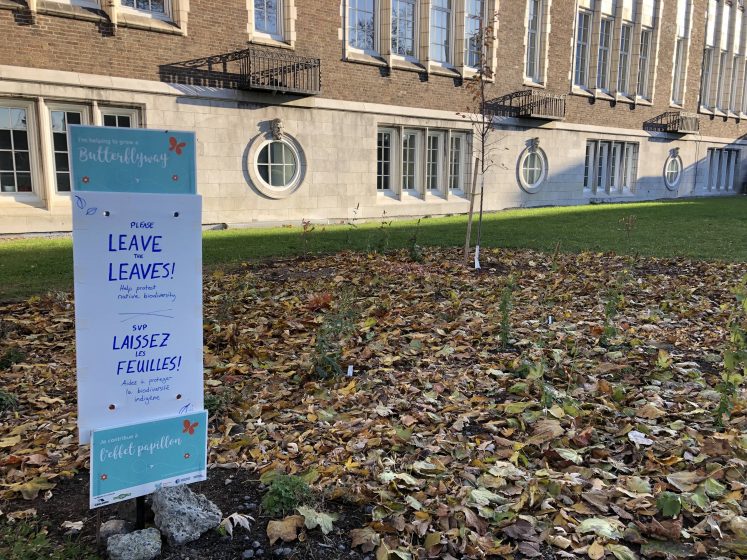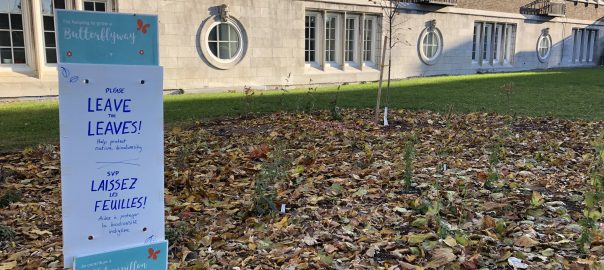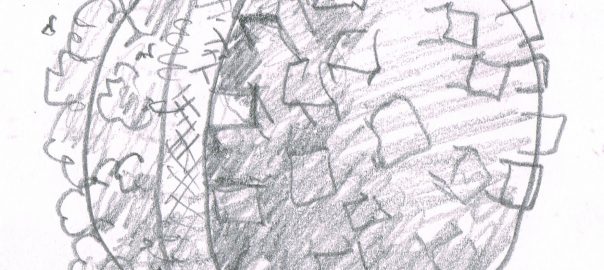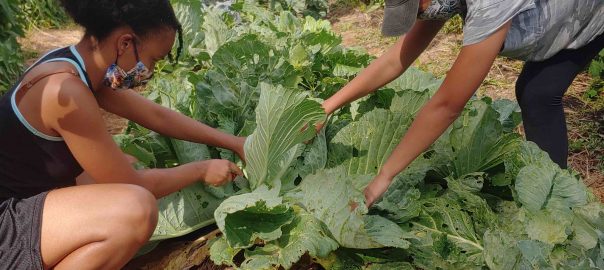What happens to tree leaves once they hit the ground? In forests, they join a litter layer that is home to countless small animals and nurtures the growth of new plants. In the city, we remove them with noisy, polluting leaf-blowers.
Reconsidering leaf blowers
Calls for the ban of leaf blowers in urban centers are on the rise, including community group initiatives, municipal bans, opinion pieces, and proposed state/provincial and national-level legislation. The reasons include noise pollution, particulates, and other conventional pollutants, greenhouse gas emissions, and ecological disruption. Understanding the interconnected nature of these risks is necessary to inform policy concerning leaf blowers.
Portable gasoline-powered leaf blowers first emerged in the 1940s in Japan and had a rapid rise in popularity in North America. In 2009 alone, 4.9 million American households purchased a leaf blower (Butterfield, 2011, as cited in Boykoff, 2011). Conventional leaf blowers feature a fossil-fuel-powered two-stroke engine, but competition is rising from increasingly available electric models. Clearly, electric engines eliminate many of the nuisances of leaf-blowers: somewhat less noise (although they are not quiet), lower CO2 emissions, and fewer conventional pollutants. However, removing leaves by whatever means can still negatively impact soil ecosystems and habitats for overwintering wildlife.
Pollution from leaf blowers
Noise pollution
Noise pollution is probably the most frequently raised problem with leaf blowers. Leaf blowers emit noises well above the recommended limit of 85 decibels, with recorded noise levels as high as 106 decibels (Walker & Banks, 2017) — high enough to cause hearing loss, hypertension, and a host of other illnesses (Basner et al., 2014), and certainly high enough to disrupt the natural soundscapes within our cities. While those operating leaf blowers often wear protective earmuffs, they are not provided to others in the area. Increased noise in urban residential areas also has negative impacts on local wildlife, potentially counteracting recent efforts to increase urban biodiversity. For example, studies on the effects of anthropogenic noise on birds, including landscaping machines, report declines in reproductive success and changes in vocal communication (Ortega, 2012).
Chemical and particulate pollutants
About 30% of the fuel used by two-stroke engines does not combust, resulting in toxic discharges in the form of aerosols such as carbon monoxide, nitrous oxides, and hydrocarbons (Boykoff, 2011). Leaf blowers, whether gas or electric, also generate air blasts of up to 200 mph, which erode topsoil and lift dust into the air, further contributing to particulate-matter air pollution (Birch & Carry, 1996). These fine particles (PM10, PM2.5), re-suspended, in the air contribute to smog and low urban air quality (Costa-Gómez et al., 2020) and are damaging to the lungs of both the operator and others nearby. It is now estimated in California that lawn care equipment produces more conventional pollutants than cars.
Greenhouse gas emissions
While conventional pollutants are clearly the greatest concern with respect to the emissions from leaf-blowers, gas-powered models, like any fossil-fuel-burning technology, also produce greenhouse gases. For example, the average fossil-fuel-powered lawn mower emits about 48 kg of greenhouse gas per year per the Government of Canada’s One-Tonne Challenge. Work by the EPA indicates that small off-road engines (mostly lawn and garden care equipment) contribute significantly to emissions of GHGs.
While the small engine of a single leaf blower produces far less greenhouse gases than does the larger engine of a single car, they still use a huge amount of energy relative to the job to be done. Decarbonization and moving toward carbon-neutrality, as many cities have pledged to do, involves a critical look at our energy use. So, let’s examine the energy used by leaf blowers. A leaf blower, whether fossil-driven or electric, operates at a power of 1200W; a person on a bicycle can generate about 100 W, maybe 200 W if they are a super athlete with a great bike. So, to recharge a leaf blower’s battery by hooking it to a bike, you would have to pedal for at least 6 hours to provide enough energy for one hour of leaf-blowing.
Ecology of leaves and leaf removal
From an ecological perspective, the culture of “manicured” landscaping contributes to the decline of insects and other small creatures, as leaf litter provides habitat and food for many different invertebrates, including pollinators (Steinberg, 2006). Falling leaves also provide an important step in nutrient cycling, as leaves are broken down by decomposer organisms and nutrients are released to the soil into be taken up by plants. Thus, the regular removal of leaf litter in urban and peri-urban areas contributes to habitat degradation and simplification of ecosystems, breaking the ecological linkages between trees, soil, and invertebrates (David & Gillion, 2009). The effects of lawn care practices on this leaf litter ecosystem is an increasing area of research in urban ecology.
Leaf litter is home to a multitude of invertebrates
Leaf litter contains astounding biodiversity, which is still poorly studied. This includes insects, centipedes, millipedes, arachnids (spiders, harvestmen, mites), molluscs (snails and slugs), earthworms, and nematode worms, not to mention countless microbes. This biodiversity undoubtedly increases soil fertility through nutrient cycling, food for birds, and other crucial ecosystem services.
A few studies show how these organisms are deeply affected by the removal of leaf litter. For example, studies of agricultural lands bordered by woodland fragments find leaf litter is heavily correlated with the distribution of millipedes (decomposers who break down organic matter and contribute to soil fertility) and centipedes (active predators that control household and garden pests) (Horňák et al., 2020). In forests, a thick leaf layer increases diversity and abundance of beetles (Koivula, et al. 1999).
Many species of insects use the leaves as food; others, including predators such as spiders, centipedes, and harvestmen, use the leaf litter as hunting grounds to capture their prey (McIntyre, 2000). Many more species use the leaf layer as protection from the cold in regions with dramatic seasonal weather patterns. Important pollinators, including many native bee species as well as butterflies and moths (e.g., swallowtails and Luna moths), depend on leaf litter for overwinter survival. Thus, while municipalities increasingly encourage residents to plant flowers in support of bee conservation, providing habitat by leaving leaves is another important action we can take.
Leaf litter and nutrient cycling
Leaf litter is one of the major factors that replenishes soil nutrients in forest and urban ecosystems (Brussaard, 1997). Invertebrates feed on leaves, and fungi and bacteria feed on their waste, releasing nutrients for plants. Leaf litter improves soil quality for plant growth (Santorufo et al., 2012). Removing leaves breaks the feedback loop that ensures soil fertility. Removing leaf litter both eliminates the source of organic matter and inhibits the community of decomposers that release nutrients, rendering human intervention necessary to maintain soil fertility, including purchasing new soil and using fertilizers to enhance soil quality (Byrne, 2004). In addition to reducing the nutrients in our urban soils, removing leaves from our green spaces can result in those nutrients ending up where they don’t belong — for example, leaves left in the street contribute to a “phosphorus-rich tea” that can cause major pollutant problems for lakes.
When we leave the leaves, we are contributing to the development of a complex soil ecosystem. The role of invertebrates in the decomposition of leaf litter is a multi-level network of interactions. Macrofauna and microfauna interact to break down leaf litter. For example, herbivorous snails eat dead leaves and the resulting snail-poop is very rich in minerals and nutrients, creating an ideal environment for fungi and bacteria, which digest the complex organic molecules and release nutrients in a form bioavailable to plants (Astor et al., 2015). Earthworms bury the faeces to a depth where they decompose faster, feed the soil microbiome, and release nutrients at the level of plant roots (Coulis et al., 2016). The snail’s mucus trails also facilitate bacterial development. In general, increased diversity of invertebrates accelerates decomposition: both snails and millipedes consume dead leaves faster when they live together (Oliveira et al., 2010). These interactions boost plant performance and, in unmanaged sites, can increase plant diversity (Bennett, 2010). Biodiversity of soil invertebrates is a good indicator of soil quality for plant growth.
What happens when you remove leaf litter?
The leaf layer is a complex ecosystem with a network of interactions, each illuminating a piece of the puzzle as to how last year’s leaves feed the growth of this year’s flowers. Removal of leaf litter has been shown to decrease invertebrate abundance and diversity in similar ways in both forests and urban systems (Smith et al., 2006; Byrne, 2004; Hartshorn, 2020; Moreno et al., 2017). The invertebrate species most heavily hit by removal of leaf litter and disturbances were the larger animals, including pollinators and ambush predators like spiders (Byrne, 2004), which help control garden pests and mosquitoes. Removing the protective layer of leaves stresses overwintering species, significantly reducing their chances of surviving the winter. A small number of species thrive in cleanly mown lawns and become dominant to the exclusion of others, sometimes to the point of becoming pests (McIntyre 2000). Overall, the removal of leaf litter decreases invertebrate biodiversity within lawns and gardens, ultimately lowering soil quality and plant health.
It is clear that manicured lawns support much lower invertebrate diversity and lower decomposition rates and nutrient cycling; however, there has been little research on detailed mechanisms, e.g., leaf removal vs lawn mowing, or on specific effects on individual species found in different regions. Ecology is very place-based and best practices for conservation will differ between regions with different climates and different species present locally. Some sample suggestions are discussed below.
Options for leaf management
Many initiatives have suggested a middle ground between removing all the leaves and just leaving them where they fall. Clearly, leaves should be removed from stairs and paths as they can pose a slipping hazard. An overly thick leaf layer on lawns can impede grass growth. While gardeners are increasingly looking to replace lawns with permacultures of native plants, some lawn areas can be desirable, especially as playing fields that encourage exercise and outdoor activity.

So, where should the leaves go? Compost bins are the most popular example of alternative places to store leaves. Leaves are also an effective mulch for flower beds, often providing the same protective cover for overwintering invertebrate species and plants while being cost-efficient. Another option is to leave leaves over winter, proceeding to pick them up in spring; in this way, they still provide an overwintering habitat for many organisms. Lastly, many gardeners do not pick up their leaves, but simply shred them with the help of a lawn mower. While this might still harm organisms found within the leaf litter, at least the nutrients are still present and can be transferred back into the soil.
Municipal bans on leaf blowers
Given the environmental and health hazards of leaf blowers and the ecological benefits of leaves, citizen groups in North American cities have been advocating for bans and regulations around leaf blowers for decades. While the initial demand often emerges from the nuisance associated with engine noise, citizen activists and municipal governments recognize the wider concerns around air pollution and its effects on wildlife and the environment. In Vancouver’s affluent West End borough, leaf blowers were banned in 2004. The Canadian National Capital Commission will ban the use of gas-powered lawn equipment in 2023. In the Montreal area, gas-powered two-stroke engine leaf-blowers have been banned in the suburban municipalities of Beaconsfield (June –September ban only, since 2018), St-Lambert (total ban since 2020), and in the Ville-Marie (2019) and Notre-Dame-de-Grâce / Côte-des-Neiges (2022) boroughs of the city of Montreal. Piece-meal bans like these are popping up across North America in response to citizen pressure.
While local initiatives often focus on banning the use of leaf-blowers, larger jurisdictions are putting in place regulations to prevent new gas-powered garden equipment from coming into use as part of their carbon neutrality strategies. The Forward Regulatory Plan for 2021-2023 from Environment and Climate Change Canada states that all new lawn and garden care equipment for sale in Canada from 2028 onward must be zero-emissions. The state of California has recently signed a similar bill to outlaw the sale of gas-powered lawn equipment by 2024. Of course, equipment purchased before these dates can continue to be used, but these initiatives clearly mark these devices as sunset technologies.
It is worth noting that none of these initiatives target electric-powered leaf-blowers. While these clearly produce less noise, fewer chemical pollutants, and lower greenhouse gas emissions than their fossil-powered counterparts, they do also generate particulate matter pollution by blowing around dust and use high amounts of energy relative to the work they do. They also disturb soil ecology as much as gas-powered models. So, beyond bans on gas-powered equipment, many are calling on urban landowners, both cities and private individuals, to simply leave the leaves!
Lidiya Beida, Felix Lambert, Emma Despland, Rebecca Tittler, and Carly Ziter
Toronto, Inujuak, Montréal, Montréal, Montréal
References
Astor, T., Lenoir, L., & Berg, M. P. (2015). Measuring feeding traits of a range of litter-consuming terrestrial snails: Leaf litter consumption, faeces production and scaling with body size. Oecologia, 178(3), 833–845.
Basner, M., Babisch, W., Davis, A., Brink, M., Clark, C., Janssen, S., & Stansfeld, S. (2014). Auditory and non-auditory effects of noise on health. The Lancet, 383(9925), 1325-1332.
Bennett, A. (2010). The role of soil community biodiversity in insect biodiversity. Insect Conservation and Diversity, 3(3), 157–171.
Birch, M. E., & Cary, R. A. (1996). Elemental carbon-based method for monitoring occupational exposures to particulate diesel exhaust. Aeroso Science and Technology, 25(3), 221–241.
Boykoff, J. (2011). The leaf blower, capitalism, and the atomization of everyday life. Capitalism Nature Socialism, 22(3), 95–113.
Brussaard, L. (1997). Biodiversity and Ecosystem Functioning in Soil. Ambio, 26(8), 563–570.
Byrne, L. (2004). The effects of lawn management on soil microarthropods. Journal of Agricultural and Urban Entomology, 21, 151–156.
Costa-Gómez, I., Bañón, D., Moreno-Grau, S., Revuelta, R., Elvira-Rendueles, B., & Moreno, J. (2020). Using a low-cost monitor to assess the impact of leaf blowers on particle pollution during street cleaning. Air Quality, Atmosphere & Health, 13(1), 15–23.
Coulis, M., Hättenschwiler, S., Coq, S., & David, J. F. (2016). Leaf litter consumption by macroarthropods and burial of their faeces enhance decomposition in a Mediterranean ecosystem. Ecosystems, 19(6), 1104-1115.
David, J., & Gillion, D. (2009). Combined effects of elevated temperatures and reduced leaf litter quality on the life-history parameters of a saprophagous macroarthropod. Global Change Biology, 15(1), 156–165.
Hartshorn, J. (2020). A review of forest management effects on eerrestrial leaf litter inhabiting Arthropods. Forests, 12(1), 23.
Horňák, O., Mock, A., Šarapatka, B., & Tuf, I. H. (2020). Character of woodland fragments affects distribution of myriapod assemblages in agricultural landscape. ZooKeys, 930,139–151.
Koivula., M., Punttila., P., Haila, Y., & Niemelä, J. (1999). Leaf litter and the small-scale distribution of carabid beetles (Coleoptera, Carabidae) in the boreal forest. Ecography, 22(4), 424–435.
McIntyre, N. E. (2000). Ecology of urban arthropods: A review and a call to action. Annals of the Entomological Society of America, 93(4), 825–835.
Moreno, M. L., Rossetti, M. R., Pérez-Harguindeguy, N., & Valladares, G. R. (2017). Edge and herbivory effects on leaf litter decomposability in a subtropical dry forest. Ecological Research, 32, 341–346.
Oliveira, T. D., Hättenschwiler, S., & Handa, I. T. (2010). Snail and millipede complementarity in decomposing Mediterranean forest leaf litter mixtures. Functional Ecology, 24(4), 937–946.
Ortega, P. C. (2012). Chapter 2: Effects of noise pollution on birds: A brief review of our knowledge – Efectos de la Polución Sonora en Aves: Una Breve Revisión de Nuestro Conocimiento. Ornithological Monographs, 74(1), 6-22.
Santorufo, L., Van Gestel, C. A. M., Rocco, A., & Maisto, G. (2012). Soil invertebrates as bioindicators of urban soil quality. Environmental Pollution (Barking, Essex: 1987), 161, 57–63.
Smith, J., Chapman, A., & Eggleton, P. (2006). Baseline biodiversity surveys of the soil macrofauna of London’s green spaces. Urban Ecosystems, 9(4), 337.
Steinberg, T. (2006). American green: The obsessive quest for the perfect lawn. WW Norton & Company. Chapter 1.
Walker E., Banks, J.L. (2017). Characteristics of lawn and garden equipment sound: A community pilot study. Journal of Environmental and Toxicological Studies, 1(1).
about the writer
Felix Lambert
Felix Lambert is currently a grade 6 teacher in Inukjuak, Quebec. His undergraduate studies were focused on terrestrial invertebrates and plant interactions in which he hopes to continue researching in future projects.
about the writer
Emma Despland
Dr. Emma Despland is a professor of ecology and invertebrate zoology in the Biology Department of Concordia University. Her research focuses on herbivorous insects and the plants they eat.
about the writer
Rebecca Tittler
Dr. Rebecca Tittler is a Lecturer and Research Coordinator at the Loyola College for Diversity and Sustainability and the Loyola Sustainability Research Centre at Concordia University. Her research background is in landscape-level forest ecology; she teaches various cross-disciplinary courses in sustainability.
about the writer
Carly Ziter
Dr. Carly Ziter is a new Assistant Professor in the Biology department at Concordia University in Montreal, associated with Concordia’s hub for Smart, Sustainable, and Resilient Cities and Communities.







Leave a Reply